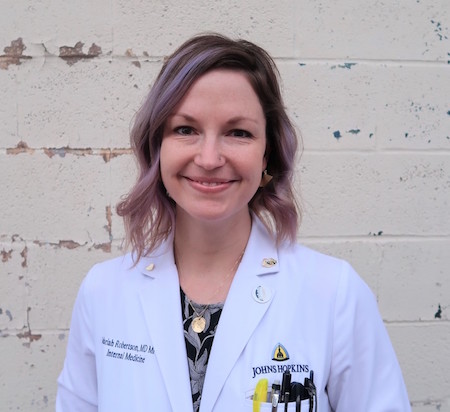Takeaway
Open and inclusive questions during routine visits with older patients can improve their sexual health outcomes.

Lifelong Learning in Clinical Excellence | June 10, 2024 | 2 min read
By Mariah Robertson, MD, Johns Hopkins Medicine
I was recently interviewed for a New York Times piece on the rise of sexually transmitted infections in older adult populations. In this discussion with the author of the piece, I was reminded that the intersection of societal and internalized ageism really impacts the sexual health of older adults. It’s hard for many people to imagine that older adults can and should continue to have a vibrant sex life if they so choose. Central to that is open and honest discussions about what might be having sex more difficult as we age.
In my practice as a geriatrician, there are natural times where discussing sex and sexuality come up. This happens in my new patient visits as I take a full social history. This includes asking:
1. Are you sexually active?
If they are not, would they like to be, but are struggling with symptoms that make being intimate challenging (for example, erectile dysfunction, vaginal atrophy, and/or decreased libido).
2. What sex were you assigned at birth?
3. What is your gender identity?*
*Note that different folx have different methods—asking first about gender identity and then sex assigned at birth versus the order above. I suggest trying it in your practice and seeing how patients feel with the different order of questions.
4. What sexual organs do you still have?
This is for prevention and screening purposes.
5. How would you describe your sexual orientation? Are you attracted to and sexually active with male partners, female partners, or both?
6. When sexually active, what type of sexual intercourse do you have?
For example, oral, vaginal, or anal.
7. Have you had new sexual partners in the past year?
8. When having intercourse with new partners are you using protection such as condoms, dental dams, other barrier methods?
Depending on their answers to these questions I provide guidance on screening for sexually transmitted infections at regular intervals and counsel patients on safe sexual practices. In older adults there are ways to remain intimate even if there are challenges with sexual dysfunction or libido changes. We discuss this as well.
I often revisit portions of the sexual history at the annual wellness visit and ensure no major changes have occurred. This also gives patients an opportunity to talk more with me if they weren’t comfortable at a previous visit. I find that being available and open to these discussions is the most important thing.
If you were uncomfortable with any of the above questions, I encourage you to practice saying them and to do some internal reflection on why it makes you uncomfortable to discuss this with older adult patients. I assure you that for every person who is surprised I am asking about this, there is a person who is grateful I did. Sexual intimacy, in its many forms, is part of healthy living and healthy aging and we shouldn’t be afraid of both encouraging it and supporting safe practices for all our patients across the life span.
Here are some resources:
NIH, sexuality and intimacy in older adults
This piece expresses the views solely of the author. It does not necessarily represent the views of any organization, including Johns Hopkins Medicine.

